|
Durbuy
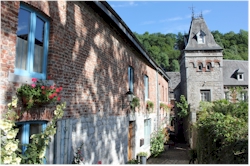 General.
This tiny town profiles itself as the smalles town in the world.
Although the marketing machine claims this to be true and
although Durbuy actually is anything but large, in reality it is
not. The popularity of this town in the heart of the
Ardennes resulted in the fact that not many people are actually
still living here. The original inhabitants had to make
way for shops, restaurants and hotels in the historic center,
which makes that it did lose a bit of its authenticity.
Despite this, it remains a beautiful place with plenty of charm:
narrow cobblestone streets, a majestic castle above the historic
center and a picturesque situation in the valley of the Ourthe
river. General.
This tiny town profiles itself as the smalles town in the world.
Although the marketing machine claims this to be true and
although Durbuy actually is anything but large, in reality it is
not. The popularity of this town in the heart of the
Ardennes resulted in the fact that not many people are actually
still living here. The original inhabitants had to make
way for shops, restaurants and hotels in the historic center,
which makes that it did lose a bit of its authenticity.
Despite this, it remains a beautiful place with plenty of charm:
narrow cobblestone streets, a majestic castle above the historic
center and a picturesque situation in the valley of the Ourthe
river.
This town is extremely popular with
visitors from Flanders and the Netherlands; on busy days you
hear more Dutch in the streets than French. This being
said, English speaking visitors should not despair because all
information signs are also in English and you will be helped in
your language with a smile.
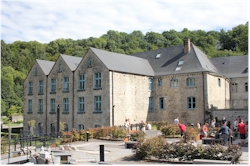 Short
history.
The area around Durbuy
has been inhabited since long time. Evidence of this can
amongst other be found in nearby
Wéris that is known for
its megalites. Durbuy itself became a county in the 11th
century but it depended on the larger county of Namur. In
that period, the first castle was built. In the 12th
century Durbuy transitted to the county of Luxembourg.
Situated in the north of this county, it became a very important
place for the defense of the territory. To accomplish its
military role, the stronghold was reinforced and the settlement
that had emerged in the meantime at the foot of the castle was
walled. In 1331, Durbuy was granted town privileges by
John I of Bohemia, the count of Luxembourg. Franciscan
friars and nuns settled in Durbuy and arranged for a side branch
of the Ourthe river to be drained. They remained an
important community until the religious order was abolished at
the end of the 18th century. In the 20th century, Durbuy
was discovered by tourism and especially during holiday periods
and weekends it can be very busy in the little town. Short
history.
The area around Durbuy
has been inhabited since long time. Evidence of this can
amongst other be found in nearby
Wéris that is known for
its megalites. Durbuy itself became a county in the 11th
century but it depended on the larger county of Namur. In
that period, the first castle was built. In the 12th
century Durbuy transitted to the county of Luxembourg.
Situated in the north of this county, it became a very important
place for the defense of the territory. To accomplish its
military role, the stronghold was reinforced and the settlement
that had emerged in the meantime at the foot of the castle was
walled. In 1331, Durbuy was granted town privileges by
John I of Bohemia, the count of Luxembourg. Franciscan
friars and nuns settled in Durbuy and arranged for a side branch
of the Ourthe river to be drained. They remained an
important community until the religious order was abolished at
the end of the 18th century. In the 20th century, Durbuy
was discovered by tourism and especially during holiday periods
and weekends it can be very busy in the little town.
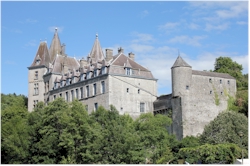 Castle.
The castle is one of the most prominent places of interest of
Durbuy. The first stronghold was constructed in the 11th
century and was reinforced in the course of the 13th century
when it had to defend the northern borders of the county of
Luxembourg. In the 18th century, the castle came in the
possession of the important noble family d'Ursel. They had
it rebuilt in 1731. The present look dates back to a
restoration that was performed around 1880. The noble
family d'Ursel still has ownership of the domain. Castle.
The castle is one of the most prominent places of interest of
Durbuy. The first stronghold was constructed in the 11th
century and was reinforced in the course of the 13th century
when it had to defend the northern borders of the county of
Luxembourg. In the 18th century, the castle came in the
possession of the important noble family d'Ursel. They had
it rebuilt in 1731. The present look dates back to a
restoration that was performed around 1880. The noble
family d'Ursel still has ownership of the domain.
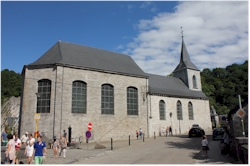 Saint-Nicolas
church. This church (l'église Saint-Nicolas) was
consacrated in 1643 and initially this was actually the convent
church of the Franciscan cloister that was situated just next to
it. When the religious order was abolished (at the end of
the 18th century), the church became the parish church of Durbuy
in 1810 with Saint-Nicolas as patron saint. Saint-Nicolas
church. This church (l'église Saint-Nicolas) was
consacrated in 1643 and initially this was actually the convent
church of the Franciscan cloister that was situated just next to
it. When the religious order was abolished (at the end of
the 18th century), the church became the parish church of Durbuy
in 1810 with Saint-Nicolas as patron saint.
Grain hall.
There are a number of beautiful old buildings in the historic
town center but it's mainly the ancient Grain Hall (also called
the Spanish house) that catches the eye due to its impressive
half-timbered facade. The hall was mentioned for the first
time in 1380 but in its present condition, the building would
date back to the 16th century. Initially this was a
covered market place but throughout the centuries it has served
different purposes. Nowadays it is used as an exhibition
space. The hall is registered as exceptional patrimony of
the Walloon region.
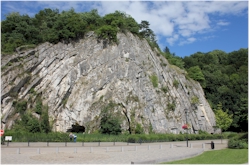 Nature.
You never need to look far to find nature in the Ardennes: woods,
hills,... Here the river Ourthe flows right next to the
small town. The anticlinal rock that you can find right
next to the center is an exceptional natural phenomenon.
An anticlinale is a fold in the landscape (due to pressure,
shifts in the earth's crust) making different earth layers
visible in a bend of the surface. The oldest layers are
the ones situated in the middle of the bend. Impressive to
see. Nature.
You never need to look far to find nature in the Ardennes: woods,
hills,... Here the river Ourthe flows right next to the
small town. The anticlinal rock that you can find right
next to the center is an exceptional natural phenomenon.
An anticlinale is a fold in the landscape (due to pressure,
shifts in the earth's crust) making different earth layers
visible in a bend of the surface. The oldest layers are
the ones situated in the middle of the bend. Impressive to
see.
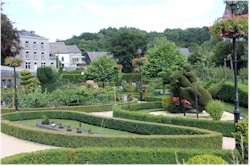 Topiary
Park. This is a plant park on the opposite
side of the river Ourthe. You can see herbs, hedges and
shrubs that are cut into different shapes (such as animals or
humans). Topiary
Park. This is a plant park on the opposite
side of the river Ourthe. You can see herbs, hedges and
shrubs that are cut into different shapes (such as animals or
humans).
Sports.
The region of Durbuy is very well-known for outdoor sports.
The river Ourthe very suitable for kayaking or canoeing and the
woods are excellent for hiking or mountainbiking. You can
even do rock-climbing. There are numerous possibilities in
the area for sporty or adventurous excursions. If you
prefer to do it a bit slower, then you could try your chances at
the midget golf course just next to the church of Durbuy.
How to get
to
Durbuy? By far the easiest way is to get there
with own transportation. The old town center is mainly
car-free but there are several large parkings just outside the
town (walking distance).
Tours &
info. Durbuy is not big and it's easy to explore
on foot. If you want to go a bit further, then you can
take one of the touristic trains (gathering point is at the
tourist office). The tourist office is located on the Place aux Foires.
Links.
- Tourist Office Pays d'Ourthe et Aisne:
www.ourthe-et-aisne.be
- Tourist Office Durbuy:
www.durbuyinfo.be/index.php/en/
Picture 1: Narrow street in the
hirstoric center of Durbuy
Picture 2: Part of the former Récollets convent with the midget
golf course in front of it
Picture 3: The castle (château d'Ursel)
Picture 4: The Saint-Nicolaschurch
Picture 5: The anticlinal rock (Roche anticlinale)
Picture 6: The topiary park (le parc topiaire)
|

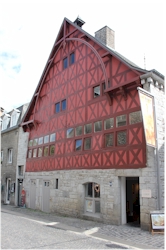
 General.
This tiny town profiles itself as the smalles town in the world.
Although the marketing machine claims this to be true and
although Durbuy actually is anything but large, in reality it is
not. The popularity of this town in the heart of the
Ardennes resulted in the fact that not many people are actually
still living here. The original inhabitants had to make
way for shops, restaurants and hotels in the historic center,
which makes that it did lose a bit of its authenticity.
Despite this, it remains a beautiful place with plenty of charm:
narrow cobblestone streets, a majestic castle above the historic
center and a picturesque situation in the valley of the Ourthe
river.
General.
This tiny town profiles itself as the smalles town in the world.
Although the marketing machine claims this to be true and
although Durbuy actually is anything but large, in reality it is
not. The popularity of this town in the heart of the
Ardennes resulted in the fact that not many people are actually
still living here. The original inhabitants had to make
way for shops, restaurants and hotels in the historic center,
which makes that it did lose a bit of its authenticity.
Despite this, it remains a beautiful place with plenty of charm:
narrow cobblestone streets, a majestic castle above the historic
center and a picturesque situation in the valley of the Ourthe
river. Short
history.
The area around Durbuy
has been inhabited since long time. Evidence of this can
amongst other be found in nearby
Short
history.
The area around Durbuy
has been inhabited since long time. Evidence of this can
amongst other be found in nearby



